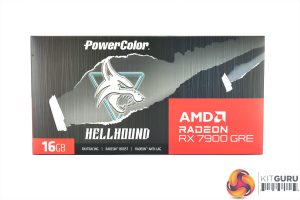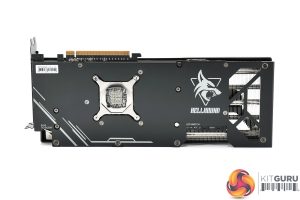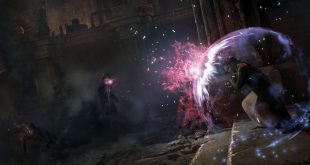The PowerColor RX 7900 GRE Hellhound ships in a black box, with the Hellhound logo slap bang in the middle and AMD Radeon branding positioned in the bottom left corner. On the back, PowerColor highlights various key features of the card, as well as system minimum requirements.
Interestingly, there are no included accessories or quick start guides in the box.
As for the card itself, if you saw our review of the 7800 XT Hellhound, you will be instantly familiar with the 7900 GRE model, as it's exactly the same design. That means it's a relatively simple-looking card, but it still looks relatively sleek and appealing. The shroud is made of dark grey plastic and doesn't feature any raised sections or sharp angles, giving it a fairly stripped-back appearance that I think works well.
The three fans grab your attention, too, with their translucent fan blades, designed to amplify the LED lighting (as shown below). Interestingly, the central fan is smaller than the outer two at 90mm, while the others measure 100mm across. The central fan also spins in reverse, a now-common feature designed to reduce airflow turbulence.
Dimensions are the exact same as the 7800 XT model, too, measuring in at 322 mm x134 mm x 50 mm. It's not small, but it's funny how a 2.5 slot card looks relatively thin nowadays! It weighed in at 1267g on my scales.
The front side of the card is left very open, allowing a good chunk of hot air to escape from the heatsink.
As for the backplate, this is made of metal and spans the length of the card, but with four small cut-outs towards the end to allow air to pass through the heatsink.
We can also note the dual-BIOS switch positioned next to the I/O bracket, giving users a choice of either the OC or Silent modes. The OC BIOS increases power, clocks and fan speed compared to Silent, but we test both later in this review.
There's another switch next to the power inputs, and this controls the LED lighting. You can either set it to Ice Blue, Amethyst Purple or completely off. I did question this choice in my 7800 XT review, but judging by the comments on our YouTube video, plenty of readers love the idea of a hassle-free way to control the LEDs, while no software is required either. I personally think RGB control would look even better, but I can see the appeal of this simpler approach.
Elsewhere, we find two 8-pin power connectors, while display outputs are standard, with 3x DisplayPort 2.1 and 1x HDMI 2.1.
 KitGuru KitGuru.net – Tech News | Hardware News | Hardware Reviews | IOS | Mobile | Gaming | Graphics Cards
KitGuru KitGuru.net – Tech News | Hardware News | Hardware Reviews | IOS | Mobile | Gaming | Graphics Cards














